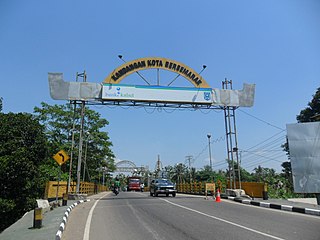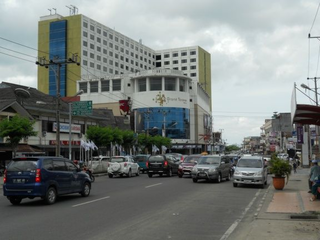The transmigration program was an initiative of the Dutch colonial government and later continued by the Indonesian government to move landless people from densely populated areas of Indonesia to less populous areas of the country. This involved moving people permanently from the island of Java, but also to a lesser extent from Bali and Madura to less densely populated areas including Kalimantan, Sumatra, Sulawesi, Maluku and Papua. The program is currently coordinated by Ministry of Villages, Development of Disadvantaged Regions, and Transmigration.

Nias is an island located off the western coast of Sumatra, Indonesia. Nias is also the name of the archipelago of which the island is the centre, but also includes the Batu Islands to the south-east and the small Hinako Islands to the west. Nias Island covers an area of 5,625.0 km2 (2,171.8 sq mi). It is mostly a lowland area rising to around 800 m (2,600 ft) above sea level. There were 756,338 inhabitants on the island at the 2010 Census; at the 2015 Intermediate Census this had risen to 798,506 and the 2020 Census resulted in a total of 880,550. The official estimate as at mid 2022 was 902,632.
Law of Indonesia is based on a civil law system, intermixed with local customary law and Dutch law. Before the Dutch presence and colonization began in the sixteenth century, indigenous kingdoms ruled the archipelago independently with their own custom laws, known as adat. Foreign influences from India, China and the Middle East have not only affected culture, but also the customary adat laws. The people of Aceh in Sumatra, for instance, observe their own sharia law, while ethnic groups like the Toraja in Sulawesi still follow their animistic customary law.

Kandangan is a district and the regency seat of South Hulu Sungai Regency in South Kalimantan province. The district covers an area of 106.71 square kilometres. According to the mid 2022 official estimates, the population of the district was 49,604 people spread across 4 urban kelurahan and 14 rural villages (desa).

Bontang is a city on the eastern coast of the island of Borneo in Indonesia, in the province of East Kalimantan. It occupies an area of 161.88 km2 (62.50 sq mi), and the population was 140,787 at the 2010 census, and 178,917 at the 2020 census; the official estimate as of mid-2022 was 183,161. It is also the third most densely populated place in the province after Balikpapan and Samarinda.

Tarakan is an island and co-extensively the sole city within the newly established Indonesian province of North Kalimantan. The island city is the largest city in North Kalimantan population wise and is located in northern Borneo, midway along the coast of the province. The city boundaries are co-extensive with the island. Once a major oil-producing region during the colonial period, Tarakan had great strategic importance during the Pacific War and was among the first Japanese targets early in the conflict. It is the sole city within the newly established Indonesian province of North Kalimantan. According to Statistics Indonesia, the city had a population of 193,370 at the 2010 Census and 242,786 inhabitants at the 2020 Census; the official estimate as at mid 2022 was 248,972 (comprising 128,895 males and 120,077 females.

Tana Tidung Regency is a regency within the Indonesian province of North Kalimantan. It is Indonesia's least populous regency, with 25,584 inhabitants recorded in the 2020 census; the official estimate as at mid 2022 was 27,571. Its regency seat is the town of Tideng Pale, in Sesayap District, where 11,280 of the regency's population lived in mid 2022.

Ministry of Research and Technology of the Republic of Indonesia was a government ministry that has the task of conducting affairs in the field of research, science and technology to assist the President of Indonesia in carrying out state. The ministry was formerly known as the Ministry of Research, Technology and Higher Education of the Republic of Indonesia.

The Ministry of State Secretariat is a government ministry responsible for providing technical, administrative, and analytical support to the President and Vice President in the exercise of their state powers. The current minister of state secretariat is Pratikno, who previously served as Rector of Gadjah Mada University in Yogyakarta.

The Office of the Attorney General of the Republic of Indonesia is the competent authority to advise the Government of Indonesia on matters of law. It serves as the central organization for the Indonesian Public Prosecution Service. The Attorney General's Office is seated in the national capital Jakarta.
In Indonesia, a regional regulation is a regulation that is passed by Indonesian local governments and carry the force of law in that region. There are two levels of regional regulations. Provinces pass provincial regulation, while the second tier subdivisions of Indonesia, known as regencies and cities pass regency regulation and city regulation, respectively. Each type of regional regulation is passed by the region's parliamentary body together with their chief executive.

National Cyber and Crypto Agency, is Indonesia's primary signal intelligence agency, as well as cyber intelligence, cyber threat intelligence, cyber defense, and cyber security agency.
National Dayak Customary Council is an official customary council of the Dayak people in Indonesia that acts as the highest authority over other cultural or traditional councils of the Dayak people. It has branches from the provincial level to the village level in the entire Kalimantan and is funded by the Indonesian government. It was established on 5 September 2006 after the 2nd National Indonesian Dayak Conference in Pontianak regarding matters of funding the organization and its structure, and has been incorporated into laws by various local governments in Kalimantan. The president of the council is elected by representatives of regional branches for a five year term. The current president of the council from 2021 to 2026 is Marthin Billa, who was previously regent of Malinau Regency and chief of the North Kalimantan provincial Dayak Council.

Cigarette advertising in Indonesia is presently allowed, and as of 2021, Indonesia is the only country in the world to allow cigarette advertising. However, it is prohibited to show cigarettes and advertising must include smoking warning messages. In Indonesia itself, such advertisements are known under the name iklan rokok in Indonesian. In 2003, cigarette advertising and promotions in Indonesia was valued at $250 million. In addition to television and outdoor advertisements, sporting events sponsored by cigarette brands or companies also occur.
The People's Consultative Assembly, the bicameral legislature of Indonesia, passed a series of resolutions of the People's Consultative Assembly or TAP MPR throughout the 1960s, to the very last issued in 2003.

The Reserve Component of the Indonesian National Armed Forces is the military reserve force of Indonesia, jointly managed under the General Headquarters of the Indonesian National Armed Forces and the Indonesian Ministry of Defense.
Ciomas is a kecamatan in Bogor Regency, West Java, Indonesia. It is located near the provincial border with Banten, about 21 kilometers southwest of the regency capital Cibinong, and 3 kilometers west of the city center of Bogor. It borders Bogor Barat in the north, Bogor Selatan in the east, Tamansari in the south, and Dramaga in the west. In 2021, Ciomas has a total population of 172,336.

The region of Rebana or Rebana Metropolitan Area is a metropolitan region located in West Java province, Indonesia. Designated area initiated by Ridwan Kamil, the Governor of West Java, Rebana is a new urban-based development area that encompasses the core urban areas of Cirebon-Patimban-Kertajati, along with its supporting areas such as Cirebon Regency, Sumedang Regency, Indramayu Regency, and Kuningan Regency.

The fifty rupiah coin (Rp50) is a denomination of the Indonesian rupiah. It was first introduced in 1971 and last minted in 2003. As of 2020, only aluminum Rp50 coins dating from 1999 through 2003 remain legal tender, although it is rarely seen in circulation due to its extremely low value.

National Strategic Projects are Indonesian infrastructure projects which are designated as strategic in increasing economic growth, equitable development, community welfare and regional development. It was established during the administration of President Joko Widodo. PSN is regulated through a presidential regulation, while project implementation is carried out directly by the central government, regional government, and/or business entities as well as Government-Enterprise Cooperation (KPBU), prioritizing the use of domestic components. The legal basis for PSN is Presidential Regulation No. 3 of 2016 which was successively amended by Presidential Regulation No. 58 of 2017, Presidential Regulation No. 56 of 2018, and Presidential Regulation No. 109 of 2020.














